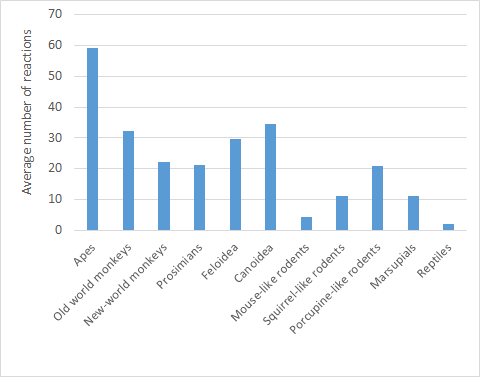Creativity and flexibility
Many traits are strongly influenced by genetic inheritance. Through random mutations in the genome, new features and traits can emerge in the course of evolutionary history and be passed on to subsequent generations through reproduction and genetic inheritance.
However, many living beings can also adapt to a certain degree by changing their behavior or learning new behaviors. Supposedly, a significant change in behavior that was “invented” by our ancestors, and which gave them a survival advantage, was the production of certain novel stone tools.
But how do such novel behaviors emerge in a population? Biologists investigate in experiments the behavior of different species to assess their ability to innovate, i. e. how curious, innovative, creative, flexible or inventive the animals are.
How would you design such an experiment to compare the curiosity, behavioral flexibility or creativity of different animal species, if you were a behavioral biologist?
Already in the 1960s, a series of experiments was conducted with representatives of more than 100 species of mammals and reptiles in different zoos: 49 primate species, 23 predator species, 15 rodent species, 6 primitive mammals, and 19 reptile species. The animals were individually placed in a cage in which certain objects were placed: wooden blocks, steel chains, wooden posts and rubber hoses. The researchers then observed for each object type over a period of six minutes how the animals handled these objects: how often would they come into contact with the objects or direct their attention and orientation to the object. These observations indicated a measure of the curiosity of the animals.

Source: based on Glickman & Sroges (1964)
What tendencies can we see in the left diagram? According to the results of this experiment, which animal species show the least curiosity, which ones the most?
Find the different animal species in a phylogenetic tree. How are they related to each other and to us humans?
In another experiment biologists not only examined whether animals show a certain curiosity when dealing with a new object, but also how diverse their occupation with the object is. The researchers were interested in how many different behaviors the animals are showing and what body parts they use.
Nylon ropes were provided to various primate species, and then the researchers observed how individuals would deal with these objects over a period of 45 minutes – how many body parts they used (hands, arms, feet, legs, tail, torso), what different actions they performed (e.g. throw, bite, push, pull, twist …), and which parts of the rope they dealt with. The researchers emphasize that the animals were not rewarded in any way for their behavior (for example, feeding them after they showed a specific reaction).

Source: based on Parker (1974)
What tendencies can we see in the left diagram? Which primate species show the greatest innovative capacity, flexibility or creativity according to the results of this experiment?
Why do the researchers stress that the animals were not rewarded or punished for certain behaviors?
Find the different primate species in a phylogenetic tree. How are they related to each other and to us humans?
Wolfgang Köhler was one of the first scientists to observe the intelligence and behavior of chimpanzees in experiments. His experiments in insight learning are well known. They show how chimpanzees try to reach a goal (e.g. to reach a banana) by constantly trying out new behaviors and using objects that are lying around. Without this urge to try out, they would probably not be able to find a solution to the challenge and improve it through practice.
What could we conclude from the results of these animal observations about the importance of innovation and creativity in the evolutionary history of our species?
see also: Cumulative culture
Importantly, our ability to try out new things can get thwarted with language and our tendency to imitate the people around us. With language, we create rules in our mind, and we communicate rules to others, that we tend to stick to in a rather rigid way -” Things should be done this way or that way” etc.
As a result, humans can actually be less creative or flexible than other apes when searching solutions to certain tasks!
see also:
These amazing creative animals show why humans are the most innovative species of all – Kevin Laland, 2017, The Conversation
References
- Glickman, S. E., & Sroges, R. W. (1966). Curiosity in Zoo Animals. Behavior, 26(1), 151–188. Retrieved from https://www.jstor.org/stable/4533136
- Parker, C. E. (1974). Behavioral diversity in ten species of nonhuman primates. Journal of Comparative and Physiological Psychology, 87(5), 930–937. http://doi.org/10.1037/h0037228
- Pope, S. M. (2018). Differences in Cognitive Flexibility Within the Primate Lineage and Across Human Cultures: When Learned Strategies Block Better Alternatives. Neuroscience Institute Dissertations. Retrieved from https://scholarworks.gsu.edu/neurosci_diss/33
- Reader, S. M., Morand-Ferron, J., & Flynn, E. (2016). Animal and human innovation: novel problems and novel solutions. Philosophical Transactions of the Royal Society B: Biological Sciences, 371(1690), 20150182. https://doi.org/10.1098/rstb.2015.0182
- Suddendorf, T., & Whiten, A. (2007). Great Ape Cognition and the Evolutionary Roots of Human Imagination. In: I. Roth (Ed.), Imaginative Minds. Proceedings of the British Academy (pp. 31–59). Oxford University Press. http://doi.org/10.5871/bacad/9780197264195.003.0002

